Average Birding

Migfest 2021 - Part One
It's September, the nights are drawing in, and many birds are sensibly starting to get the hell out of the UK. Or, in some cases, return to it. It's time for us to go to Migfest.
Pronoun guidance: AB1 is betrayed by previously reliable motorways. This post covers the events of 10th-11th September, 2021.
What even is Migfest?
It's a collaboration between Spurn Bird Observatory and the BTO that combines:
- One of the best places to catch migratory birds in the UK
- Enough experts to run a programme of guided walks
- A set of nature talks by professionals, e.g scientists and this year, birding illustrator extraordinaire Killian Mullarney
- Lots of enthusiastic birders
It's also unbelievably good value: tickets were £30 each, and we paid an additional £48 for the two of us to camp at the festival site for 3 nights.
Let's go to Migfest
We're driving up from Beeston on the Friday. Our only goal is to get there early enough to not have to pitch the tent in darkness; setting off at half past two should surely guarantee this.
For once though, the trusty pairing of M1/M18 betray us - some incident has triggered the smart motorways into full on hate mode, and we crawl all the way from Tibshelf to the M62. Once we're on the road to Hull though, things improve. Although Google Maps decides that we aren't worth speaking to, so I have to guess my way through Hull, and then spot the appropriate turns to reach the festival site itself.
We arrive, finally, at around half past six. Enthusiastic volunteers direct us to the camping area. The field is dry, its grass freshly mown and the sun is out. I open the door to the car to be greeted by the sound of Curlews on the estuary. As I'm getting the tent out of the boot, a Hobby carves around the edge of the field the campsite is in. I rub my hands together with glee - what a start!
We pay a visit to the festival's marquee to obtain our wristbands and listen to the official kick-off announcements, before a speedy relocation to the nearby pub, the Crown & Anchor. Unfortunately they haven't got room to feed us, so between pints we fetch a spare sandwich from the comfortably nearby campsite. Other festivalgoers take advantage of an evening bat walk.
It gets dark. An early start beckons, as does the tent.
A long walk to the point
I'm up with the sunrise somewhere after six and head out for an explore of the nearby area while AB2 snoozes. Another Hobby makes an appearance. The Curlew voices have been replaced by constant passerine cheeps - a few Goldfinches, some Linnet, but mostly an unbelievable volume of Meadow Pipit. A pair of Yellow Wagtail fly over as I return to the tent.
We're off on the biggest walk on the programme - all the way to the end of Spurn Point. And then back, obviously. The walk departs from outside the YWT's Discovery Centre, which we arrive at just in time; thankfully the walk's organiser spots us from afar looking purposeful and waits for us to draw level.
We've got three experts for nine walkers; an excellent ratio. We're off without too much further ado - we need to get across a particular part of the walk before high tide, or the sea will get in the way.
The walk takes us out past a previous incarnation of the bird observatory. It sits on an extended bank of land that obscures a view of the sea behind. To our right, though, we have uninterrupted views of the Humber estuary. Which, for the record, is enormous. A big group of Swallows are feeding over the vegetation that's growing at the edge of the water, and a Curlew or two are poking about too. Meadow Pipits are a constant presence overhead; apparently a Southwesterly wind is often a trigger for this sort of visible migration (or VizMig, as we'll refer to it henceforth).
That in itself is interesting - are the birds being pushed out of the centre of the UK by the wind, and then using the lee of the coast to continue South? We ask them, but they're off before they can answer, though their numbers certainly suggest so.
The walk heads on to the beach. There once was a road that traversed this area, but it was washed away in 2013, and there do not appear to be plans to rebuild it. Getting to the point speedily now is best done by a fat-tyred e-bike, or on the YWT's Unimog Safari.
We're on foot though, so the game of "walk on the wet sand without the sea washing your shoes" is, ahem, afoot. It comes with the added twist of birding - can you keep your bins on something and remember to avoid the sea? I, apparently, cannot, and after several warnings from other members of the group, I give up. The clouds of birds in the distance over the headland will have to be identified later.
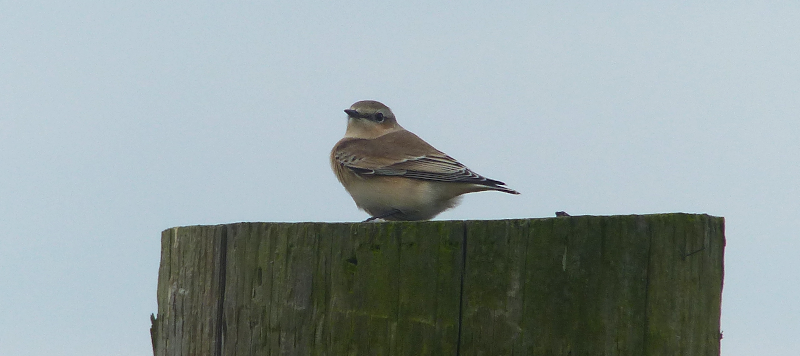
We climb back off the beach onto a more solid ground some time later. More Meadow Pipits join us. Further on, the day's first Wheatear sits waiting for us on some giant rocks. This sequence repeats: Meadow Pipits fly over, and the next visible perch point for a Wheatear always has a Wheatear on it. Lovely.
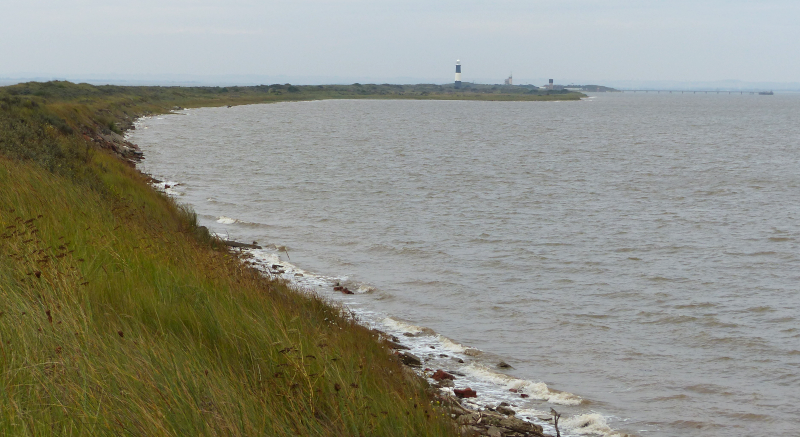
Some variety is added by a Mediterranean Gull (an unspeakably good bit of ID from one of our experts) and a Tree Pipit hiding out on the rocks on the Humber side of our path. An impressive effort is made to get everyone on this - the bird is sitting on rocks significantly below the path, so we have to jink back a bit, climb down some fairly hairy areas and then wait for it to move out to an appropriate perch point.
We've definitively seen Tree Pipit this year, so after our first view we have a little explore - there's a cut into the bank between us and the seaward side - and, oh my goodness, there's an unbelievable number of waders sitting there at the water's edge. Knot, Grey Plover, Ringed Plover, Dunlin, Sanderling, all sitting perhaps ten metres away. I mention this to one of the guides, Nathan, (who has also moved on from the Tree Pipit), but of course he already knows. He isn't confident, however, we can show the waders to the wider group without disturbing the birds. A secret bird pact it is then. Deal.


Nathan is an unstoppable fount of bird and Spurn knowledge. We eagerly accept both. AB2's noticed occasional sections of railway line in the path: "Ah yeah - they built that to help fortify the peninsula during WWI. People used to zip up and down the tracks on carts with sails - the original use of wind power round here". True Story, and, amusingly the Wikipedia page for sail trolleys informs us that another place we like, Cliffe, was a former site for these things too.
The discussion continues into "fortifying it for what reason?" until a sign (and another expert) tells us we are now arriving in Chalk Bank. Here the headland has been bolstered artificially by the addition of chalk, hence the name. There's a hide looking over a sandy spit here; hopefully it will have more public waders? There's a Wheatear on top of it, at least!
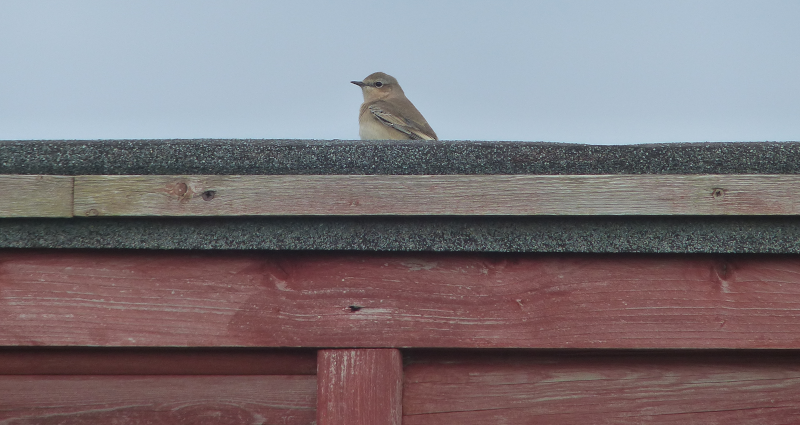
We spend too long photographing the Wheatear and are last in - I end up wedging myself into the far right-hand corner of the hide. Unwittingly, this ends up offering the best view of the end of the spit, where all the good stuff is. The end is covered in Curlew - forty birds or so? Among them there are a few Bar-tailed Godwit, and one or two Knot. There's plenty of Oystercatchers here too, and, accompanying them, some Turnstones poking about. To the left of the spit several Cormorants sit drying their wings. A solitary Eider duck floats around in the estuary behind them. Further out, a lost-looking Guillemot's floating about too. Very nice.
We exit the hide and continue towards the point. Here the headland widens and the path enters a grassy meadow that must be fabulous on the right day. For us though, it brings yet more Meadow Pipits. Mad.
We exit the meadow into a more undulating area; this is Spurn Warren. A raptor carves its way along the seaward edge of the headland. Excitingly, it's a Merlin. Given they primarily eat Meadow Pipit, perhaps this should be unsurprising; still, it's a real treat to catch up with one. We trace it all the way to the lighthouse, where it turns around, then drops below the bank between us and the sea. It turns up for one final peek above the parapet immediately to our left, before swiftly making its disappearance.
Speaking of swifts - we see one heading in the opposite direction. That's almost certainly the last Swift we'll see this year (he says, suppressing a sob). Another bit of obscenely good bird id occurs - Nathan picks out a Tree Pipit from two Meadow Pipits as they fly by some 25m away. Skills.
News of inbound Honey Buzzard from the radio (another brilliant feature of Migfest - the experts broadcast sightings via walkie-talkie, to the excitement of anyone within earshot) has the team (definitely a team now) marching past the lighthouse and up to the top of the dunes to its left. No Honey Buzzard is found - apparently it went inland after briefly considering a trip South (and was later found to be Common Buzzard anyway!). The secret birding pact notes the continued bird gravel on the now distant sand; there are even more waders in the roost now than when we sneaked a look earlier.
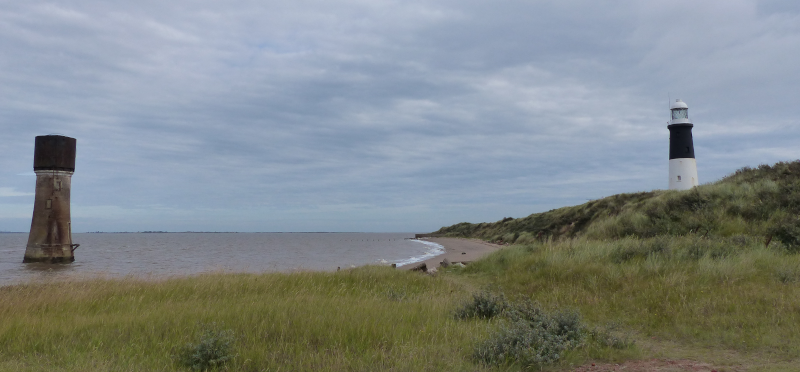
Having passed the lighthouse, we start to approach Spurn Point proper. Just before we get there we look back down a beach on the Humber side where a collection of Sanderlings are scampering around. Lovely.
Entering the RNLI area of the point, more Wheatears greet us in Wheateary places, and we pay a visit to a most welcome loo. We're just starting to look at the Ternery (definitely a thing) gathered on the extensive lifeboat jetty when we realise we've left the giant bridge camera lens somewhere between here and the Chalk Bank hide. Well, it's not a very wide peninsula, and we haven't strayed too far from paths, so with a bit of luck we'll find it on our way back.

A bit on the RNLI station here - it's now the only lifeboat station with a full-time crew in the UK. There are houses here, where the crew previously lived with their families. Nowadays there's a one week on, one week off rota - the lack of road rather limiting access to the site.
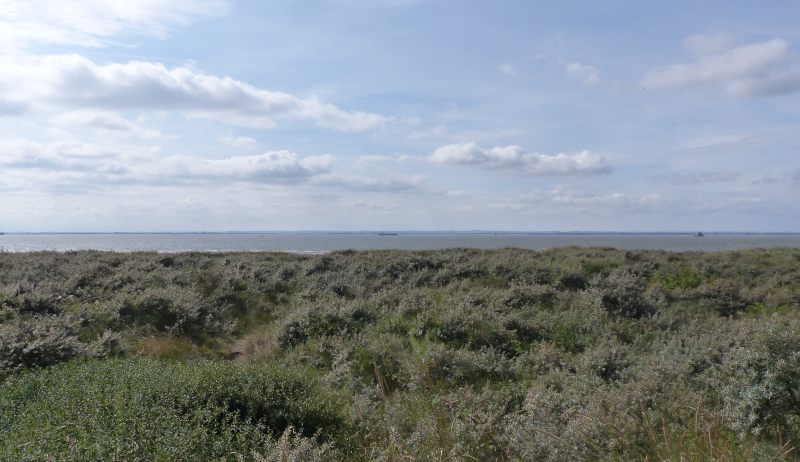
We make a solid exploration of the point itself in hope of finding migrants. A terrific amount of hard work yields next to no results - there's almost no movement in the point's bushes and trees at all. We do find what we guess is a young Cetti's Warbler (it is still singing rather than shouting) and a probable Lesser Whitethroat.
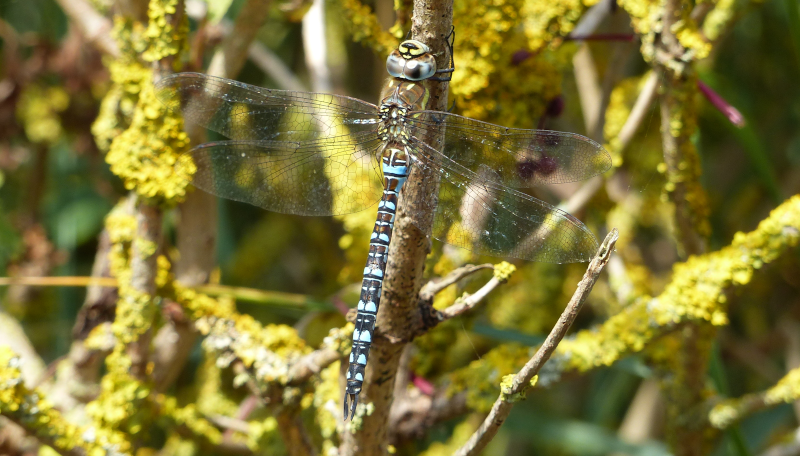
Soon though, it's time to start the journey back - not least to find that bit of glass we've put down somewhere.


We don't find it near the lighthouse, or on the sandy knoll we watched for the not-Honey Buzzard from. Curious - that's where I'd have guessed it might have fallen out of an errant side pocket. Nathan disappears into the lighthouse to ask if it's been handed in. We explore a few off path areas where the group forayed into earlier, and, thankfully, a giant bit of glass is clearly visible in a tuft of grass. How did that get there?
We give a distant Nathan a victory wave and wait for him to catch up. We spend the walk back swapping bird stories (though I think the net information flow is strongly biased in the direction of Nathan to us!). We have a check through the hole in the bank to see if the wader gravel is still present - they're all gone, the tide's dropped enough for them to be able to feed again. Nathan's originally from Hull (ish) (which explains how he knows everything, and our inability to split his accent from North-East and North-West), but is now based in North Norfolk and so of course has, to hand, videos of wader spectaculars from Snettisham, which are, if you haven't been, well-described.
He adds further information to the secret birding pact, by revealing what he believes to be the best place to watch Nightjar in Norfolk. We'll have to give that a try next year. We manage a bit more birding too - an unexpectedly high count of Sanderling on the Humber mud, and a good collection of Ringed Plovers being the highlights.
We eventually rejoin the mainland, where denizens of the seawatching hut have been hard at work. Our arrival is timely - they've got a Long-tailed Skua flying in front of one of the offshore wind farms. We have a crack at finding this with binoculars, but it's impossible. One very helpful chap proffers a scope, and, yes, there are enough pixels in it say "yes, Skua with a long tail", which is probably enough for a life-tick. Only Pomarine to go.
One final surprise awaits us on the journey back to the campsite - four Whinchats on the fence just North of the seawatching hut. Nathan tries to radio them in, but his transmitter is apparently out of battery. Our camera also chooses that moment to malfunction, meaning the Whinchats evade real recording.
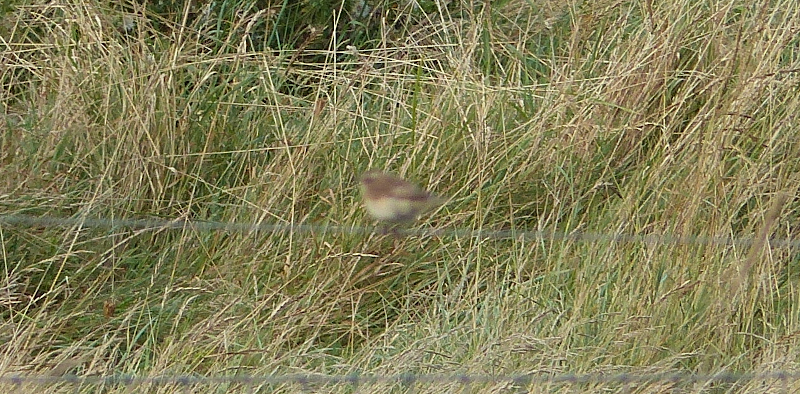
We ferret one last piece of information out of Nathan: apparently we should head up Beacon Lane to the wetlands this afternoon. No, one more - is he doing the same walk tomorrow? Indeed he is. We enthusiastically offer to send people his way. Nathan waves his hands as if to flap future hordes of questioning newbies away. We empathise.
Beacon Lane & Kilnsea Wetlands
We have a brief pit stop back at the campsite, claiming the last available portions of vegetable curry from the canteen. Very welcome. We join a thronging horde of birders waiting for the afternoon guided walk up to the wetlands. Hmmm. There are more than twenty folks here, will this break through the faff -resistance of birding groups?
A little bit - progress is a bit slow, not least because the path is quite tight, and there are folks coming the other way. Progress is not much hampered by birds, however - we're very much in bird siesta time, and we make it to the beach without getting eyes on basically anything. On the beach though: more Wheatears. Lovely. We have a toddle up the beach beyond the path into the wetlands. I forget precisely why, but it's an excellent beach and being near the sea is delightful. We have a good chat about Little Tern nest protection as well - having totally missed the day's talks we're feeling rather ignorant.
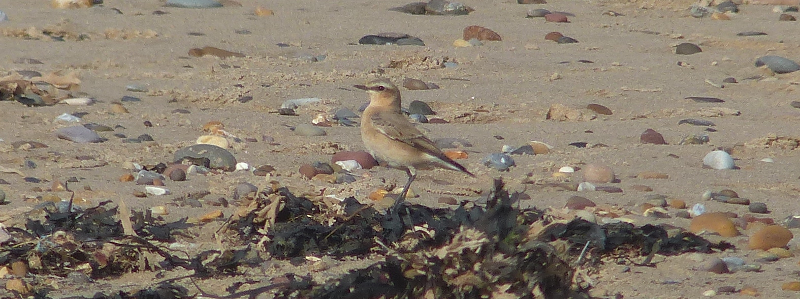
After a bit we turn back for alternative views of Wheatears, and it's into the wetlands we go. We hang back to let the group disperse a bit, and pick up even more Wheatears on the edge of a stubbly field. Finally, we arrive at the actual wetlands and the birding density increases dramatically.
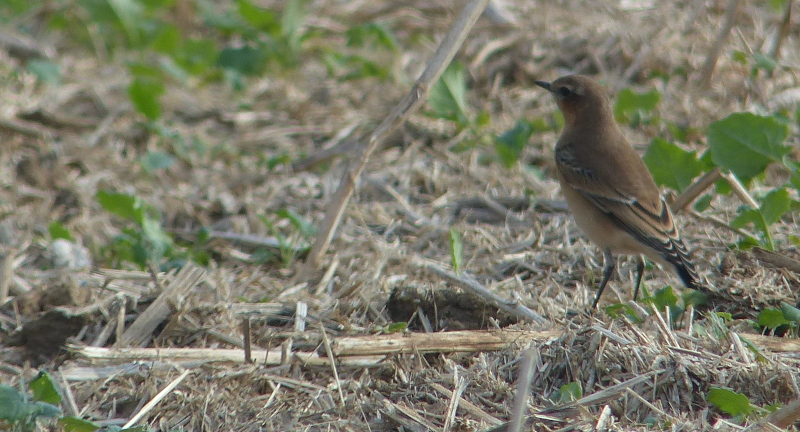
There are good numbers of Redshank here, with frequent Greenshank mixed in for good measure. If only they were a bit closer. A bit more looking around yields several Dunlin. A nearby person (who may or may not be the CEO of the BTO) reckons they've got some Godwits as well - we get the scope out to have a look, and they're quite right - there are five or six Barwits off at the back right-hand side of the pool from this viewpoint.
We move to the next viewpoint and there are a few other small waders that need examining - I'm looking at something I'm convinced is not Dunlin but small, but it disappears out of view before I can be sure what that is. Two other small birds are found off to the right; perhaps they're more interesting? I'm in the middle of getting the scope on them when a nearby radio crackles:
Eleven Short-eared Owls in the second paddock
The group is agog at this news. Where even is the second paddock? Regardless of their features, the two small waders (which I've now found) are going to be Dunlin forevermore now, as the realisation that we're going to need to try to find those owls washes over us.
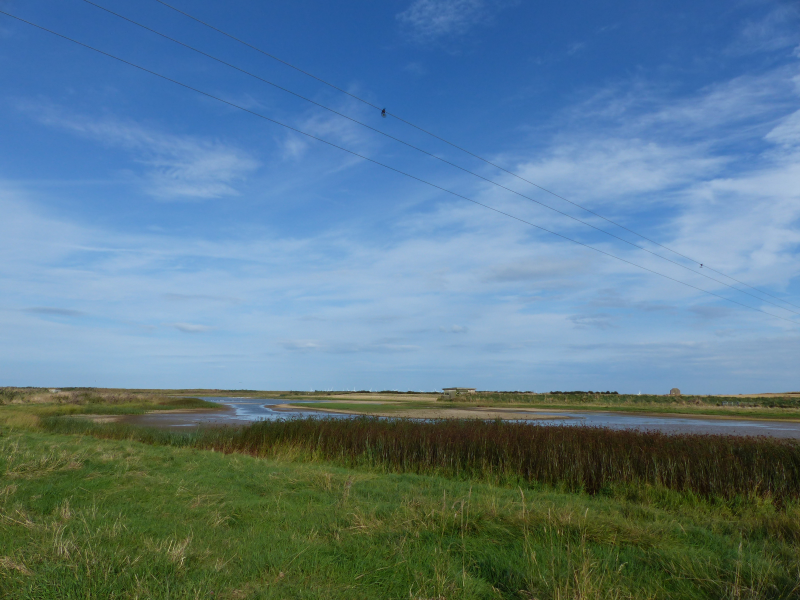
This site has other ideas, though - the nearby hide offers even better views of waders that were, from our previous stops, much further away, and a final viewing area just before the car park has Little Stint and a great many Ruff poking about in it. Surely not all eleven of those owls can instantly disappear?
Owl quest
We reconnect with our previous team at a bridge over a ditch - they're staring over fields towards the sea wall that's between the fields and the estuary. One chap has the clue - he led a walk over there this morning. "The paddocks are on this side of the sea wall, so if there were Short-eared Owl, we should be able to see them from here", he opines. We stare across the fields as well, but none of us sees an owl.
What a conundrum! There's little consensus on what to do now and the group slowly splits up as we walk back towards the pub. We consult the Migfest map and find that there should be a path from this road out to the sea wall and on to Sammy's Point, which is where twitter is directing us for owls. We don't see this path, but we do find several deer, and a giant flock of Linnet distract us.
Reaching the pub, our choice is clear - there's plenty of time between now and the Migfest barbecue, we can either spend them drinking or trying a bit harder to find these owls. The latter choice wins, and we're soon heading back up the road in search of the path we missed earlier.
Amazingly, we miss it again! It's only with the advice of another expert "You've gone too far, it's right there by that post" that we finally twig what to do. We blame the Linnets. We can even see the group that we guess originally spotted the owls heading this way. At an appropriate pinch point, we block their path. We shall not let them pass unless they tell us their owl news. Thankfully, they seem happy to surrender their information "yes, this way, with the light going the way it is they might be in the air by the time you get there". Curious. Is this a trap? We yomp off along the sea wall in search of paddock two.
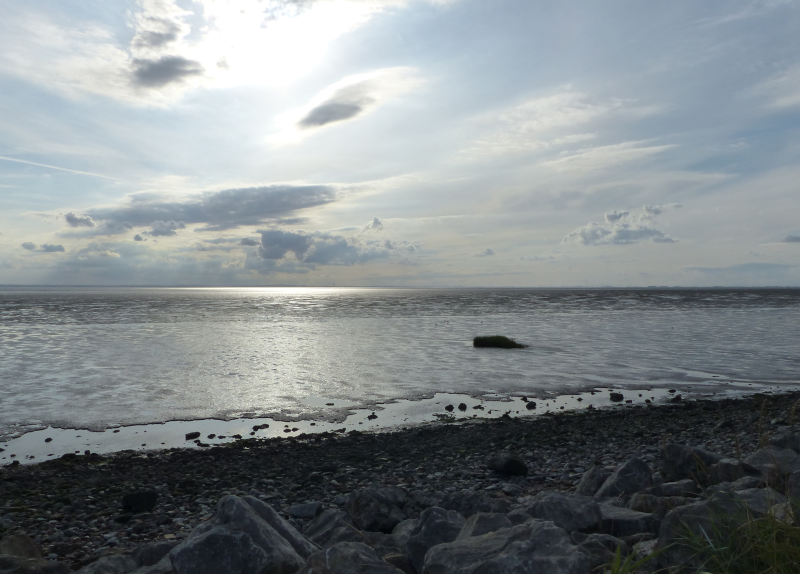
What seems like hours go by. We try the usual trick of spotting the bunch of birders rather than the bird. There is a little cluster of enthusiastic -looking people further along this path. We head in their general direction.
On arrival signs are not good - some people can see an owl, but many cannot. The instructions we get are accurate but insufficient. After a look through another scope I can see why - only the head of the bird is visible, and it's hiding on the side of a watery ditch that's mostly obscured by foliage between us and it. I have a guess at where on the sea wall we might get a better perspective from, and I'm not too far wrong; I can even pick out a second owl when someone mentions it's there.
We spend a few minutes sharing our scope view - this is seriously tricky, because a) the scope isn't stable and b) neither is the place you need to stand to use it. It's worth it though - a few folks get a glimpse that turns them from righteous unbelievers into happy spectators. Even these mildly average views of Short-eared Owl can't hide the personality of the birds - their pale facial border and eyes glowing from the darkness of the ditch's bank. No, no we don't have any pictures, it was hard enough getting them in the scope!
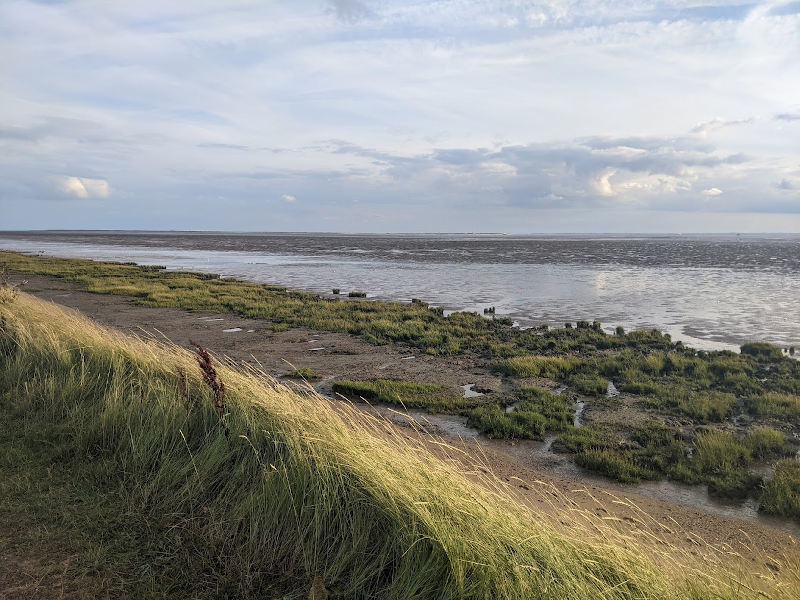
Owl quest complete (albeit nine owls short - perhaps the original reporter was reading two tally marks?), we return along the sea wall to the pub. The views out on to the estuary are superb, not least due to the Shelduck on the mud. There's time for a swift pint at the Crown and Anchor before returning to the marquee for the barbecue and quiz. Any plan of returning to the pub is disregarded; having birded the living daylights out of Saturday, we're both ensconced in our sleeping bags and asleep by 9pm.